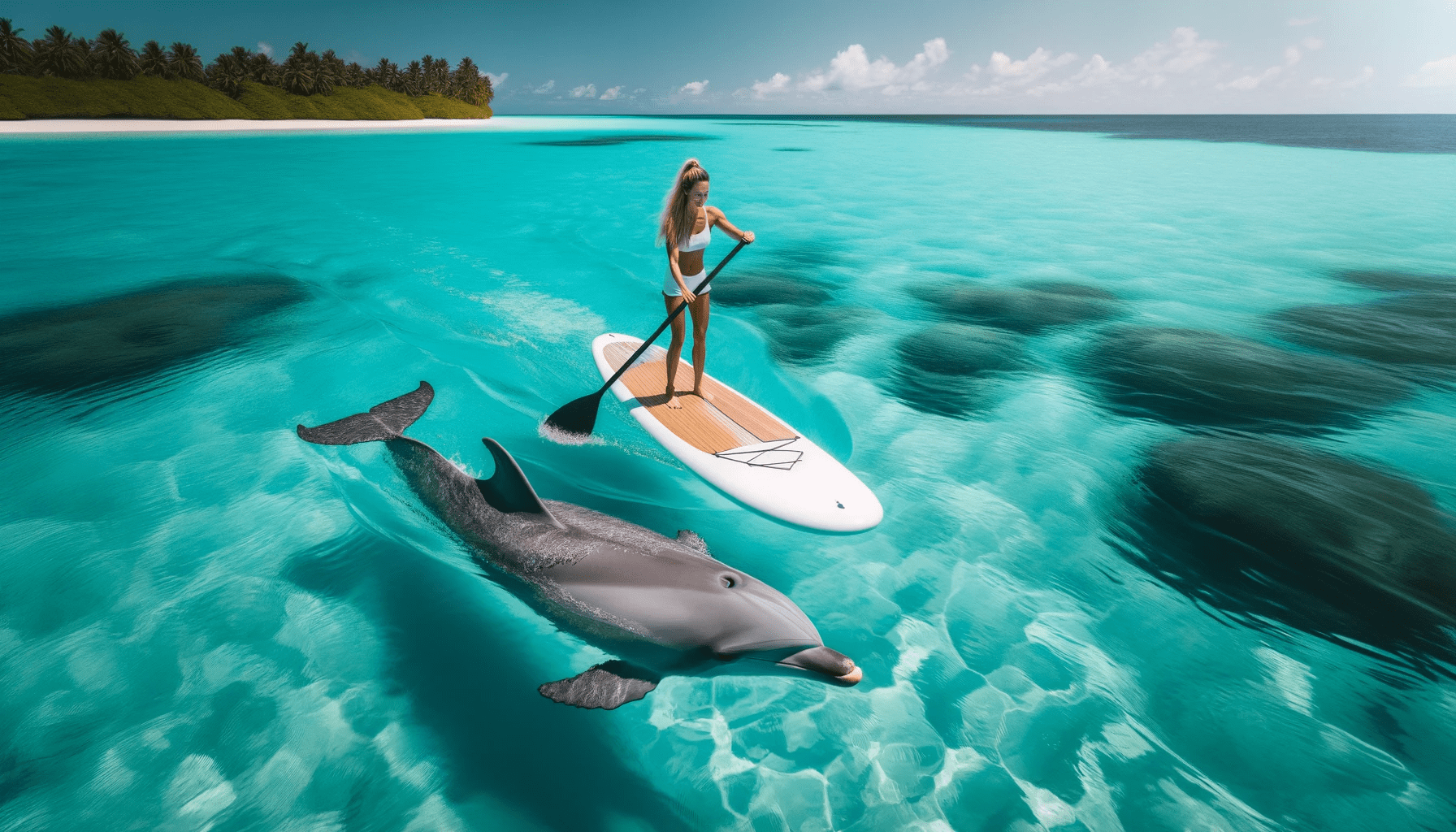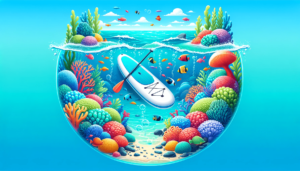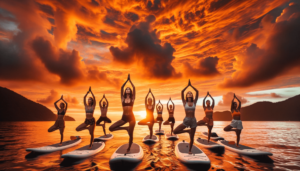Looking to hit the water and enjoy the freedom of paddleboarding? Before you dive in, it’s essential to have the right gear and know how to stay safe.
In this article, we’ll explore the must-have equipment for paddleboarding and provide practical safety tips for a worry-free experience.
From choosing the perfect paddleboard to mastering proper paddling technique, we’ve got you covered.
Get ready to make a splash and embrace the exhilarating world of paddleboarding.
Choosing the Right Paddleboard
When choosing the right paddleboard, it’s important to consider factors such as your skill level, intended use, and body weight. These factors will help determine the paddleboard size that’s most suitable for you. For beginners or those looking for versatility, a larger paddleboard is recommended as it provides better stability and easier balance. On the other hand, experienced paddlers or those interested in speed and maneuverability may prefer a smaller board.
Another important consideration is whether to opt for an inflatable or rigid paddleboard. Inflatable paddleboards have gained popularity in recent years due to their portability and easy storage. They’re made from durable materials and are designed to be inflated with an air pump. Rigid paddleboards, on the other hand, are made from solid materials such as fiberglass or carbon fiber. They offer better performance and speed, making them ideal for advanced paddlers or those looking for a more intense workout.
Now that you have a better understanding of paddleboard size and the differences between inflatable and rigid boards, let’s move on to the next section where we’ll discuss the essential gear you need for a safe and enjoyable paddleboarding experience.
Essential Gear for Paddleboarding
One must-have piece of gear for paddleboarding is a personal flotation device (PFD). A PFD is crucial for ensuring safety while out on the water. It’s designed to keep you afloat in case you fall off your paddleboard. When choosing a PFD, make sure it fits properly and is approved by the Coast Guard.
In addition to a PFD, there are other essential gear items that can enhance your paddleboarding experience. Paddleboard accessories such as a leash and a waterproof bag are great investments. A leash will keep your board close by in case you fall off, while a waterproof bag will protect your belongings from water damage.
When it comes to paddleboard clothing, it’s important to dress appropriately for the weather conditions. If it’s a hot and sunny day, wear lightweight and breathable clothing to stay cool. On the other hand, if it’s colder, consider wearing a wetsuit or drysuit to keep warm. Don’t forget to wear sunscreen and a hat to protect yourself from the sun’s harmful rays.
Safety Tips for Paddleboarding
To ensure a safe paddleboarding experience, it’s important to follow these essential safety tips:
- Master Paddleboarding Techniques
- Learn the proper paddleboarding techniques before hitting the water. This won’t only improve your skills but also enhance your safety on the board.
- Take lessons from a certified instructor or join a paddleboarding group to gain valuable knowledge and tips from experienced paddlers.
- Avoid Common Paddleboarding Mistakes
- One of the most common mistakes isn’t wearing a leash. Always attach a leash to your ankle or leg to prevent your board from drifting away in case you fall off.
- Another mistake is overestimating your abilities. Start with calm waters and gradually progress to more challenging conditions as you gain confidence and skill.
By mastering paddleboarding techniques and avoiding common mistakes, you can ensure a safe and enjoyable experience on the water. Remember to always wear a personal flotation device (PFD) and check weather conditions before heading out. Stay aware of your surroundings and be respectful of other water users.
With these safety tips in mind, you can fully embrace the freedom and adventure that paddleboarding offers.
Proper Paddling Technique
When it comes to proper paddling technique, body positioning and efficient paddle strokes are key.
Maintaining the right body position while paddling, such as keeping the knees slightly bent and the core engaged, helps improve stability and balance on the board.
Additionally, learning and practicing efficient paddle strokes, like using a smooth and fluid motion, can enhance the efficiency and power of each stroke, making the paddling experience more enjoyable and effective.
Body Positioning While Paddling
Proper paddling technique requires maintaining a balanced and stable body position on the paddleboard. To achieve this, it’s important to focus on proper body alignment and prevent muscle strain.
Here are some tips to help you maintain the right position while paddling:
- Stand with your feet shoulder-width apart, parallel to the board’s centerline.
- Keep your knees slightly bent to absorb shock and maintain stability.
- Engage your core muscles to maintain balance and prevent strain on your lower back.
- Hold the paddle with a relaxed grip, keeping your arms straight and shoulders relaxed.
- Rotate your torso as you paddle, using your core muscles instead of relying solely on your arms.
- Look ahead and maintain a forward-facing posture to maintain stability and control.
Efficient Paddle Strokes
To achieve efficient paddle strokes and proper paddling technique, it’s crucial to focus on body alignment and paddle placement.
One key aspect is maintaining a proper grip on the paddle. It should be held with both hands, slightly wider than shoulder-width apart, allowing for a comfortable and firm grasp.
When paddling, the technique involves using your core muscles and engaging your entire body, rather than relying solely on your arms. Start by positioning your body in a slightly forward stance, with your feet shoulder-width apart and knees slightly bent.
As you paddle, make sure to fully submerge the paddle blade into the water and use a smooth, fluid motion to pull it back towards you. Remember to keep your arms straight and avoid hunching your shoulders.
Preparing for Different Water Conditions
As paddleboarders venture out onto various bodies of water, it’s crucial for them to be prepared for different water conditions by selecting the appropriate gear and adjusting their techniques accordingly. Whether paddling on a calm lake or tackling ocean waves, understanding the potential water hazards and weather conditions is essential for a safe and enjoyable paddleboarding experience.
Here are some key points to consider:
- Water hazards:
- Familiarize yourself with the specific body of water you’ll be paddling on, including any potential hazards such as rocks, currents, or submerged objects.
- Always wear a leash to ensure you stay connected to your board in case of falls or strong currents.
- Weather conditions:
- Check the weather forecast before heading out and be aware of any potential changes throughout your paddle.
- Avoid paddling in strong winds or thunderstorms, as these conditions can make it difficult to maintain control and balance on your board.
Staying Safe and Protecting the Environment
Paddleboarders must prioritize safety and environmental conservation while out on the water. Not only does this ensure their own well-being, but it also contributes to the preservation of the marine ecosystem they enjoy.
When paddleboarding, it’s important to be mindful of weather conditions and their potential impact on the environment.
One aspect of marine life conservation is avoiding disturbing or harming marine animals. Paddleboarders should maintain a safe distance from wildlife, refraining from approaching or feeding them. This helps to minimize stress and interference in their natural habitat. Additionally, it’s crucial to paddle in designated areas to prevent damage to fragile ecosystems, such as coral reefs or seagrass beds. These areas serve as important breeding grounds and habitats for various marine species.
Weather conditions also play a significant role in paddleboarding safety and environmental conservation. It’s essential to check the forecast before heading out and be aware of any potential changes in weather patterns. High winds, strong currents, or storms can pose risks to paddlers and may also disturb the environment. Paddleboarders should avoid paddling in unsafe conditions and be prepared to change plans if necessary.
Frequently Asked Questions
Can I Use a Regular Surfboard for Paddleboarding?
Yes, a regular surfboard can be used for paddleboarding. However, it’s not ideal as paddleboards are specifically designed for stand up paddleboarding techniques, providing better stability and maneuverability on the water.
What Should I Do if I Fall off My Paddleboard?
If someone falls off their paddleboard, it is important to know paddleboard safety and rescue techniques. They should stay calm, grab their board, and climb back on. It’s helpful to wear a leash and a personal flotation device for added safety.
Are There Any Age Restrictions for Paddleboarding?
Age restrictions for paddleboarding vary depending on the location and regulations. It is important to check with local authorities before allowing children to participate. Safety guidelines, like wearing a life jacket, should be followed by all paddlers.
Can I Bring My Pet on a Paddleboard With Me?
Yes, pets can be brought on paddleboards with proper safety precautions. It is important to ensure the pet is comfortable, secure, and wearing a life jacket. Gradually introduce them to the board to minimize any potential stress.
What Is the Best Type of Clothing to Wear While Paddleboarding?
When it comes to paddleboarding, choosing the right clothing is crucial for comfort and safety. Different weather conditions call for different attire, and having the appropriate footwear is equally important for a smooth and enjoyable experience.



